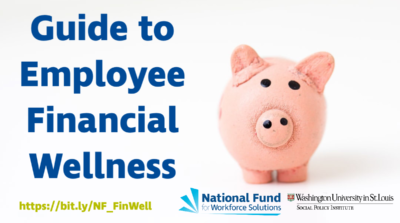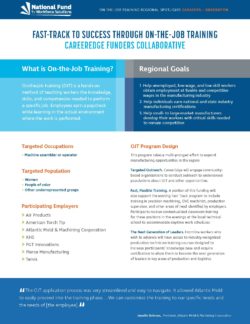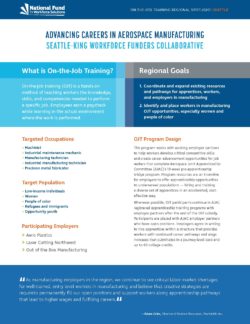|
Guide to Employee Financial WellnessAlmost half of low-wage workers find it difficult to “just get by” on their regular income. A single unforeseen expense can upend their lives. Throw a pandemic and economic crisis on top of that, and their situation becomes even more unstable. Workers are bringing this stress into the workplace, and many employers are trying to do something about it. The Guide to Employee Financial Wellness, developed by the National Fund for Workforce Solutions and the Social Policy Institute at Washington University in St. Louis, provides a straightforward, step-by-step process for employers considering a financial wellness program to support their frontline workers. President’s CornerLast week I had the pleasure of appearing on a panel discussion hosted by the Federal Reserve to discuss how COVID-19 is affecting our communities. I and my fellow panelists, representing a range of industry, labor, higher ed, and community organizations, brought our various perspectives, but together wove a story that we all know, and that Chairman Jerome Powell encapsulated perfectly in his opening remarks: “We are in an economic downturn without modern precedent. It has already erased the job gains of the last decade and has inflicted acute pain across the country.” I talked about the work that the National Fund is doing and will continue to do to support businesses and frontline workers, to champion industry partnerships and promote quality jobs. And I made it clear that we can’t go back to the way things were. The last time we had a crisis of this magnitude, the United States created the New Deal. And it intentionally left out black and brown workers, which we feel the effects of even today. As we work to recover from this economic calamity, we need to make sure we’re rebuilding an economy that really works for everybody. Amid the frightening news, however, there was hope. I’ll leave you with Chairman Powell’s closing words: “We had a tantalizingly good situation a few months ago, with a tight labor market…opportunities were coming to low and moderate income communities that hadn’t been seen in a long, long time. And so this is a hard, hard blow…But you guys are all about hope–you’re about lighting a candle…The economy will recover. It will take time. Fairly soon we’re going to be on the road to recovery and making progress…We’re going to get there. It may not take as long as it feels like it will take now, and I think all of us need to work together…We’ve got to help each other through this. And that’s what we’re going to do.” Responding to an Unprecedented Challenge
The COVID-19 situation is not just impacting the healthcare industry, it is fundamentally changing our communities and how we live our lives. It is also shining a light on our collective understanding of who is an essential worker during a pandemic. Investing in these workers and their careers has always been the mission of CareerSTAT. That hasn’t changed during this crisis, and it won’t change during the long and challenging recovery ahead. On-the-Job Training Regional SpotlightIn-demand industries, like advanced manufacturing, require a more robust worker pipeline, and employers are clamoring for skilled workers. On-the-job training allows workers, especially women and people of color, to gain marketable skills and build relationships with employers, while employers ensure their specific workforce needs are met. Learn about two National Fund collaboratives’ efforts to implement on-the-job training in their communities.
Job Quality Tools LibraryThe Aspen Institute Economic Opportunities Program recently launched the Job Quality Tools Library, which offers tools, resources, and guidance to help organizations improve jobs. This toolkit draws from many workforce leaders across the nation, including the National Fund. We are excited to have some of our materials included in the library and look forward to seeing how this resource can be utilized to make jobs better! Blog RoundupIn a Changed World, It Matters How We Think About What to Do Next– Bryan LindsleyEmployees Are Stressed About Money. Financial Wellness Benefits Can Help.– Ellen G. Frank-MillerOn-The-Job Training Regional SpotlightsRe-Thinking Employee Benefits After COVID-19– Ellen G. Frank-MillerSuccess Across the NetworkMedia and Articles
National Fund for Workforce Solutions SUBSCRIBE TO OUR NEWSLETTER TO STAY UP TO DATE WITH WORKFORCE DEVELOPMENT ACROSS THE COUNTRY |













